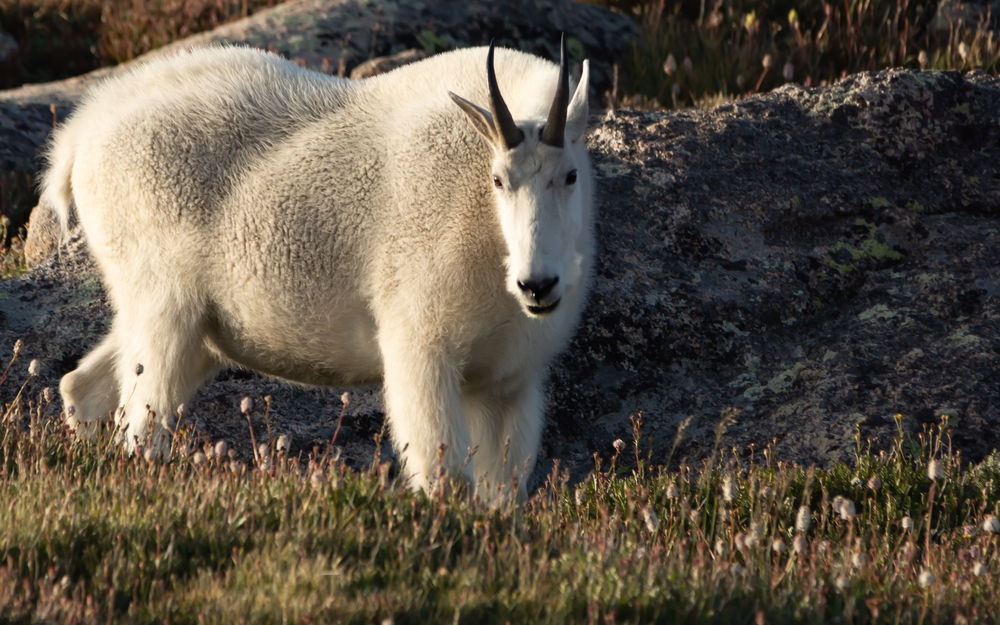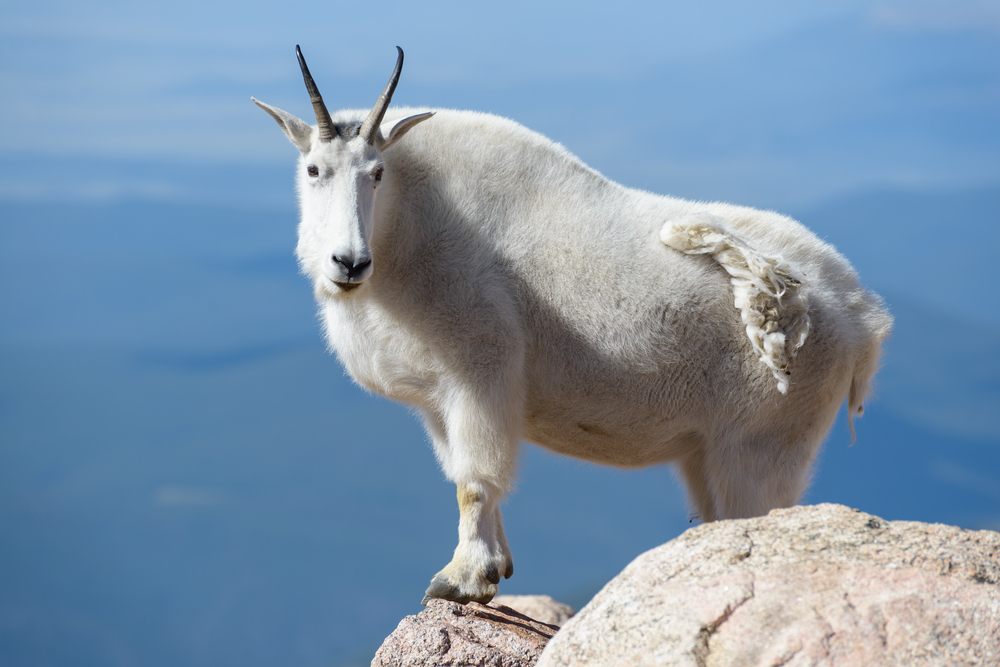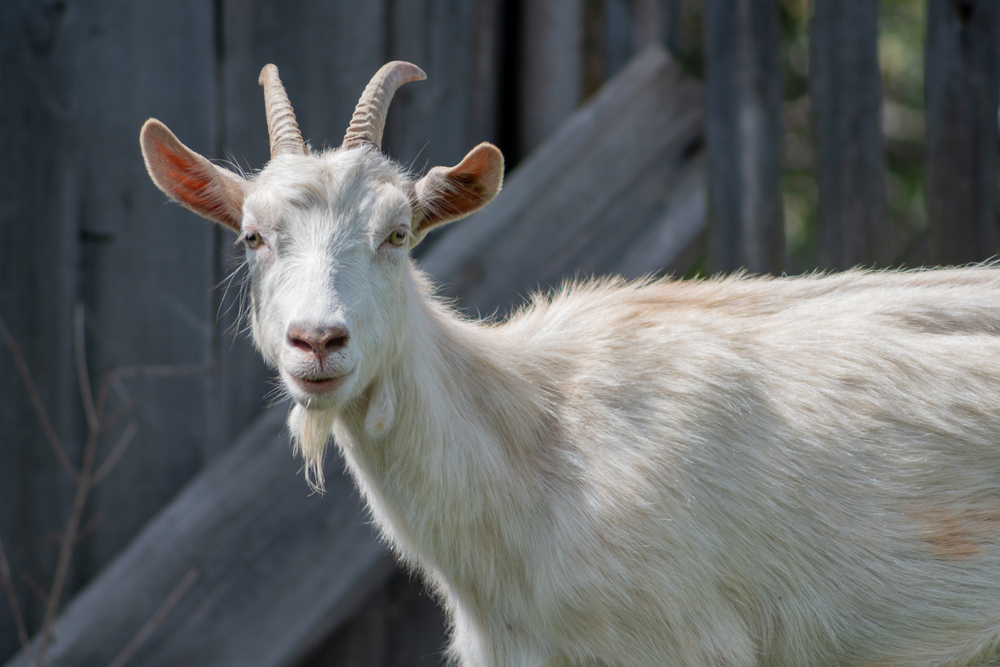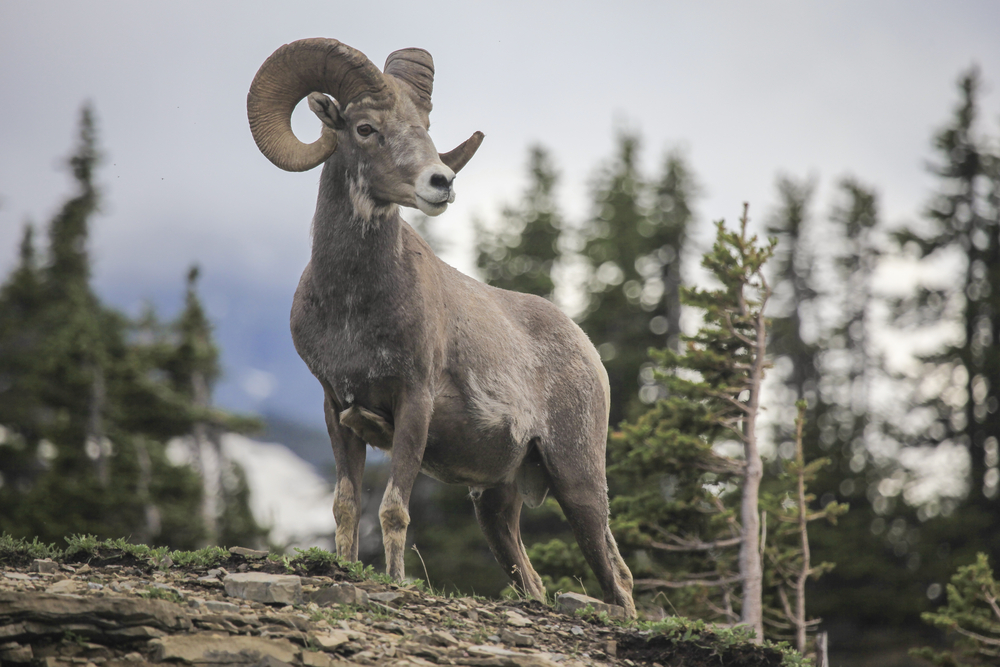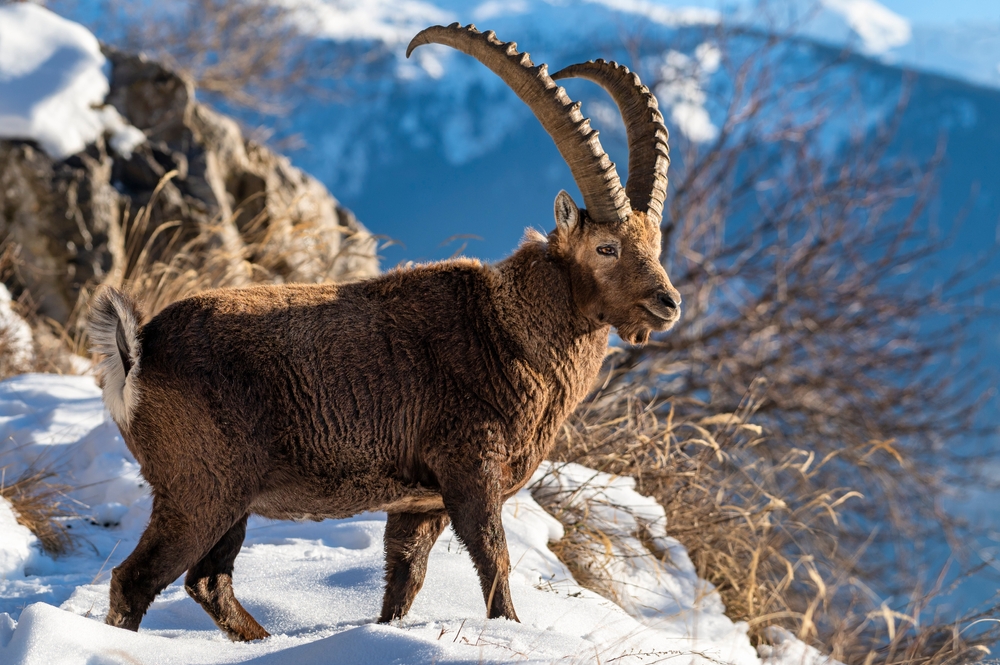The mountain goat (Oreamnos americanus) is most closely related to other goat-antelopes in the subfamily Caprinae, particularly the chamois (Rupicapra rupicapra) and the serow (Capricornis spp.), rather than true goats (Capra species) like the Alpine ibex.
About
The mountain goat (Oreamnos americanus) is a sure-footed alpine mammal renowned for its climbing ability and belongs to the family Bovidae, which also includes antelope, cattle, sheep, and goats. Despite its name, it is not a true goat but rather a goat-antelope, uniquely adapted to the rugged mountains of northwestern North America. Native to the Rocky Mountains, Cascade Range, and coastal ranges of Alaska and British Columbia, the mountain goat thrives at elevations of 1,500–4,000 meters (4,900–13,100 feet).
Mountain goats are covered in a thick, white double coat—an insulating wool underlayer topped by long guard hairs—that protects them from extreme cold and high winds. Males (billies) weigh 80–140 kg (180–310 lbs), while females (nannies) are smaller at 56–91 kg (125–200 lbs). Both sexes sport slender, black, slightly curved horns that can reach 20–30 cm (8–12 inches) in length.
Their greatest adaptation is their climbing skill. Specialized cloven hooves with rough, rubbery pads allow them to grip steep, rocky slopes where few predators can follow. This ability enables them to feed on alpine grasses, sedges, mosses, and lichens during summer, and on woody plants in winter when snow covers higher meadows.
Mountain goats live in small groups, with females and young forming nursery bands and males remaining solitary or in bachelor groups outside of the mating season. The rut occurs in late autumn, with kids born in spring to take advantage of milder weather and abundant forage.
While populations are generally stable, they can be sensitive to habitat disturbance, hunting pressure, and climate change, which affects alpine vegetation. They are valued as a game species, a symbol of wilderness, and a key part of the high-mountain ecosystem.
Physical Characteristics
The mountain goat (Oreamnos americanus) is a sure-footed alpine ungulate found in the high mountains of northwestern North America, known for its thick coat and exceptional climbing ability:
-
Coat: Dense, woolly double coat—long, hollow guard hairs over a soft, insulating undercoat—that keeps them warm in extreme cold. Coat is pure white to creamy in color, providing camouflage in snowy environments.
-
Head: Narrow face with a slightly convex profile and small, black eyes; short, pointed black ears.
-
Horns: Both males and females have slender, black horns that curve slightly backward, reaching 8 to 12 in (20 to 30 cm) in length with sharp tips.
-
Body: Stocky, muscular build with a short neck, deep chest, and powerful shoulders and hindquarters adapted for climbing steep, rocky slopes.
-
Legs: Relatively short but strong, with large dewclaws and cloven hooves featuring rough-textured pads that grip rock surfaces.
-
Tail: Short, covered in dense white fur.
Size:
-
Length (Body): Approximately 4.5 to 5.5 ft (1.4 to 1.7 m) from head to rump.
-
Shoulder Height: Around 3 to 3.5 ft (0.9 to 1.07 m).
Weight:
-
Adult Female (Nanny): Typically 125 to 180 lbs (57 to 82 kg).
-
Adult Male (Billy): Usually 150 to 300 lbs (68 to 136 kg).
The mountain goat’s thick coat, muscular frame, and specialized hooves allow it to thrive in rugged alpine environments where few other large mammals can survive.
Reproduction
Mountain goats have a seasonal breeding cycle adapted to the demands of alpine life, ensuring kids are born when conditions are most favorable:
-
Mating and Breeding Season:
-
The rut occurs in late fall (November to early December).
-
Males (billies) compete for access to females (nannies) through displays, posturing, and occasional horn clashes.
-
-
Gestation:
-
The gestation period lasts about 180 days (roughly 6 months).
-
-
Birth and Kidding:
-
Most births occur in late May to early June, timed for mild weather and fresh alpine vegetation.
-
Typically a single kid is born; twins are rare.
-
-
Kid Characteristics at Birth:
-
Newborns weigh 6 to 9 lbs (2.7 to 4.1 kg).
-
Born with a thick, woolly coat and strong legs, kids are able to stand and follow their mothers within hours.
-
-
Maternal Care:
-
Nannies seek secluded, steep cliff areas to give birth, reducing predator risk.
-
Kids nurse for 3 to 4 months but begin nibbling vegetation within weeks.
-
-
Maturity and Breeding Readiness:
-
Females reach breeding age at 2.5 to 3 years.
-
Males mature physically by 3 years but often do not breed successfully until 4 to 5 years, when they can compete with older rivals.
-
The mountain goat’s timed breeding season, protective birthing sites, and precocial young are key adaptations for survival in the extreme alpine environment.
Lifespan
In the Wild:
Mountain goats typically live 9 to 12 years, with females often living slightly longer than males. Harsh winters, predation, and rut-related injuries can reduce lifespan, especially for older billies.
In Captivity:
With veterinary care, reliable food, and protection from predators, mountain goats can live up to 15–18 years.
Threats to Longevity:
-
Environmental Stress: Severe winters with deep snow can limit access to forage, leading to starvation.
-
Predation: Golden eagles, wolves, cougars, and bears prey on kids and occasionally adults.
-
Injury: Males may suffer horn or limb injuries during rutting battles or from navigating steep terrain.
-
Disease & Parasites: Lungworm, lice, and bacterial infections can impact health, particularly in dense populations.
-
Avalanches & Rockfalls: Steep, unstable terrain exposes goats to natural hazards.
Mountain goats’ adaptations for climbing and cold resistance give them an advantage in rugged alpine regions, but their lifespan is still limited by environmental challenges and the physical demands of their habitat.
Eating Habits
Mountain goats are herbivorous browsers and grazers adapted to the sparse, seasonal vegetation of alpine environments:
-
Primary Diet:
-
Summer: Graze on alpine meadow grasses, sedges, herbs, clover, and wildflowers.
-
Spring: Feed on new shoots, tender leaves, and shrubs emerging after snowmelt.
-
Autumn: Consume a mix of grasses, shrubs, and lichens to build fat reserves for winter.
-
Winter: Survive on woody browse, conifer needles, mosses, and any exposed grasses they can uncover through snow.
-
-
Foraging Behavior:
-
Move between high and low elevations seasonally, following plant growth.
-
Often feed in small groups, with nannies and kids in separate bands from bachelor males outside the breeding season.
-
-
Digestive Adaptations:
-
As ruminants, have a four-chambered stomach that ferments fibrous plant material, enabling them to extract nutrients from coarse alpine vegetation.
-
-
Water Needs:
-
Obtain most water from plants and snow; drink from alpine streams and meltwater pools when available.
-
Mountain goats’ seasonal diet shifts, efficient digestion, and willingness to browse woody plants are key to their survival in nutrient-poor, high-altitude ecosystems.
Uniqueness
The mountain goat (Oreamnos americanus) is one of North America’s most specialized alpine mammals, with a set of traits that make it truly distinctive:
-
Extreme Climbing Ability: Possesses exceptional balance and agility, scaling near-vertical cliffs and narrow ledges to escape predators and access food.
-
Specialized Hooves: Cloven hooves with hard outer rims for grip and soft, concave pads for traction on rock and ice.
-
Cold-Weather Insulation: Thick, two-layer coat provides protection against temperatures as low as -50°F (-46°C).
-
High-Altitude Adaptation: Large lung capacity and efficient oxygen use enable survival at elevations above 13,000 ft (4,000 m).
-
Sexual Monomorphism: Males and females look very similar, with both having black, slightly curved horns.
-
Predator Avoidance Strategy: Uses steep, inaccessible terrain rather than speed for defense.
-
Solitary to Social Shifts: Males tend to be solitary outside the rut, while females and kids form protective herds.
The mountain goat’s blend of climbing skill, cold tolerance, and rugged beauty makes it an iconic symbol of the wild high country of North America.
Be the First to Share Photos of This Species.
FAQ’s
1. What is the closest species to the Mountain Goat?
2. How does the Mountain Goat compare to other goat species?
Mountain goats are more heavily built, colder-adapted, and cliff-specialized than true goats. They have thicker coats, shorter legs, and unique hoof pads for gripping rock and ice. While domestic and wild goats like the ibex can climb rugged terrain, mountain goats are unmatched in their ability to live year-round at extreme altitudes in freezing conditions.
3. What national parks provide the best chances to see a Mountain Goat?
Mountain goats are found in high-altitude parks and reserves across northwestern North America, including:
-
Glacier National Park (Montana, USA) – one of the best places to see them along cliff faces and alpine trails.
-
Banff National Park (Alberta, Canada) – often visible on rocky slopes and high meadows.
-
Olympic National Park (Washington, USA) – though some populations have been relocated due to habitat concerns.



































































